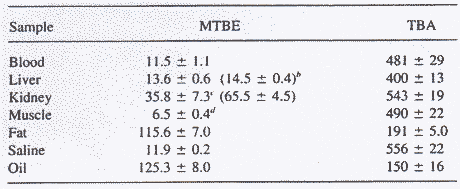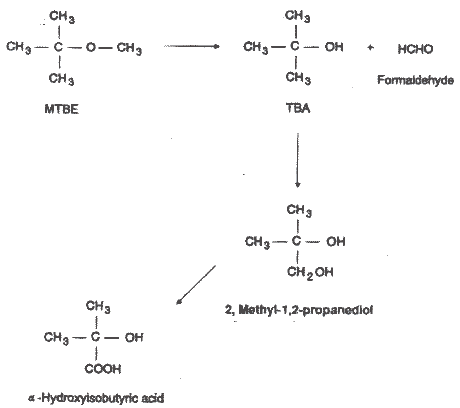|
Toxicological evaluation and limit values for Methyl-tertiary-butyl ether (MTBE), Formaldehyde, Glutaraldehyde, Furfural
2. Toxicokinetics
2.1 Absorption, distribution
Inhalation
MTBE shows a rapid uptake by inhalation exposure in humans. One-hour exposure to 5 mg/m3 MTBE produced a blood concentration of 8.2 and 14.7 mg/l in two volunteers (Prah et al. 1994). For humans exposed to 18, 90 and 180 mg/m3 for 2 hours a respiratory uptake of 32-42% was registered. The blood level of MTBE at the end of the exposure reached levels of 1.3, 6.3 and 12.2 mmole/l (0.11, 0.55 and 1.1 mg/l), respectively (Johanson et al. 1995).
In experimental animals MTBE has been distributed into the various tissues of the body (IPCS 1996). Table 2.1 shows the tissue:air distribution coefficient measured in rats after inhalation exposure to MTBE (exposure level not indicated).
Table 2.1 Tissue:air partition coefficients for MTBE and TBA determined for male F-344-rats (from Borghoff et al. 1996a).

In vitro measurements with human blood showed blood/air distribution coefficients of 17.7 (MTBE) and 462 (t-butyl alcohol, TBA) and water/ air distribution coefficients of 15.2 (MTBE) and 603 (TBA) (Johanson et al. 1995).
Oral intake
In rats 58-81% of a dose of 40 mg/kg was found to be absorbed from the gastrointestinal tract (IPCS 1996).
Dermal contact
Dermal absorption has been demonstrated in studies with rats dermally exposed to MTBE dissolved in water. Forty-eight hours after a six hours exposure to 400 mg/kg under occlusive dressing 35% of the dose was recovered from expired air (20-23%) and urine (12%) (IPCS 1996).
2.2 Elimination
Most of the absorbed MTBE amount of is rapidly eliminated from the body, mainly through expired air as the unchanged compound. MTBE is to some extent metabolised to t-butyl alcohol (TBA) and formaldehyde and oxidised to 2-methyl-1,2-propanediol and a-hydroxy isobuturic acid (IPCS 1996).
Seven hour after one hour exposure to 5 mg/m3 MTBE the concentration in blood from two volunteers had dropped from 8.2 mg/l and 14.7 mg/l to 0.2 and 0.6 mg/l MTBE. In contrast the metabolite TBA gradually increased up to a concentration of 7-10 mg/l (Prah et al. 1994).
AUC values of MTBE and TBA were proportional to exposure levels in humans exposed to 18, 90 and 180 mg/m3 for 2 hours suggesting linear kinetics. MTBE in blood indicated three half-lives of approximately 10 min, 1.5 h and 19 h (Johanson et al. 1995). Of the total inhaled dose of MTBE a fraction of 20-33% were recovered from expired air after the exposure had stopped (total absorption was in the range of 32-42% of inhaled amount). Less than 1% of the absorbed dose of MTBE was excreted as TBA in urine within 24 h, which for the remaining absorbed fraction may indicate further metabolism of TBA as shown in rats (Johanson et al. 1995).
In rats orally dosed with 40 and 400 mg/kg the plasma half-life was found to 0.6 and 0.8 h, respectively. Most of the administrated dose was exhaled as unchanged MTBE but also TBA was detected (2.8 and 1.4% at low and high dose level). In urine major metabolites were further oxidation products of TBA: 2-methyl-1,2-propanediol and a-hydroxyisobutyric acid (IPCS 1996).
Figure 2.1 Metabolism of MTBE, from Miller (1997)

Half-lives of MTBE and TBA in blood of rats have been found to 30 min for MTBE and 1.5-3.5 h for TBA depending of exposure and sex of the rats (Borghoff et al. 1996).
[Front page] [Contents] [Previous] [Next] [Top] |